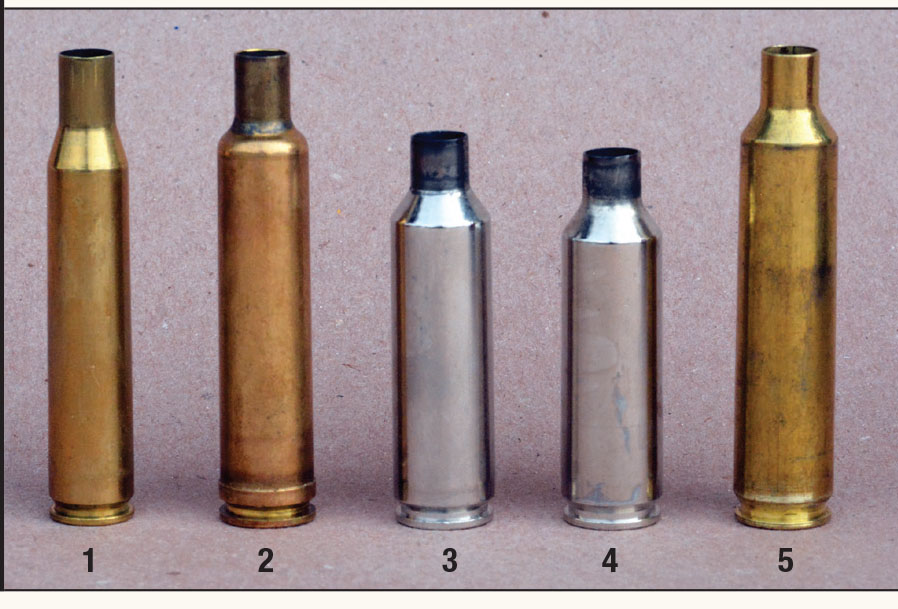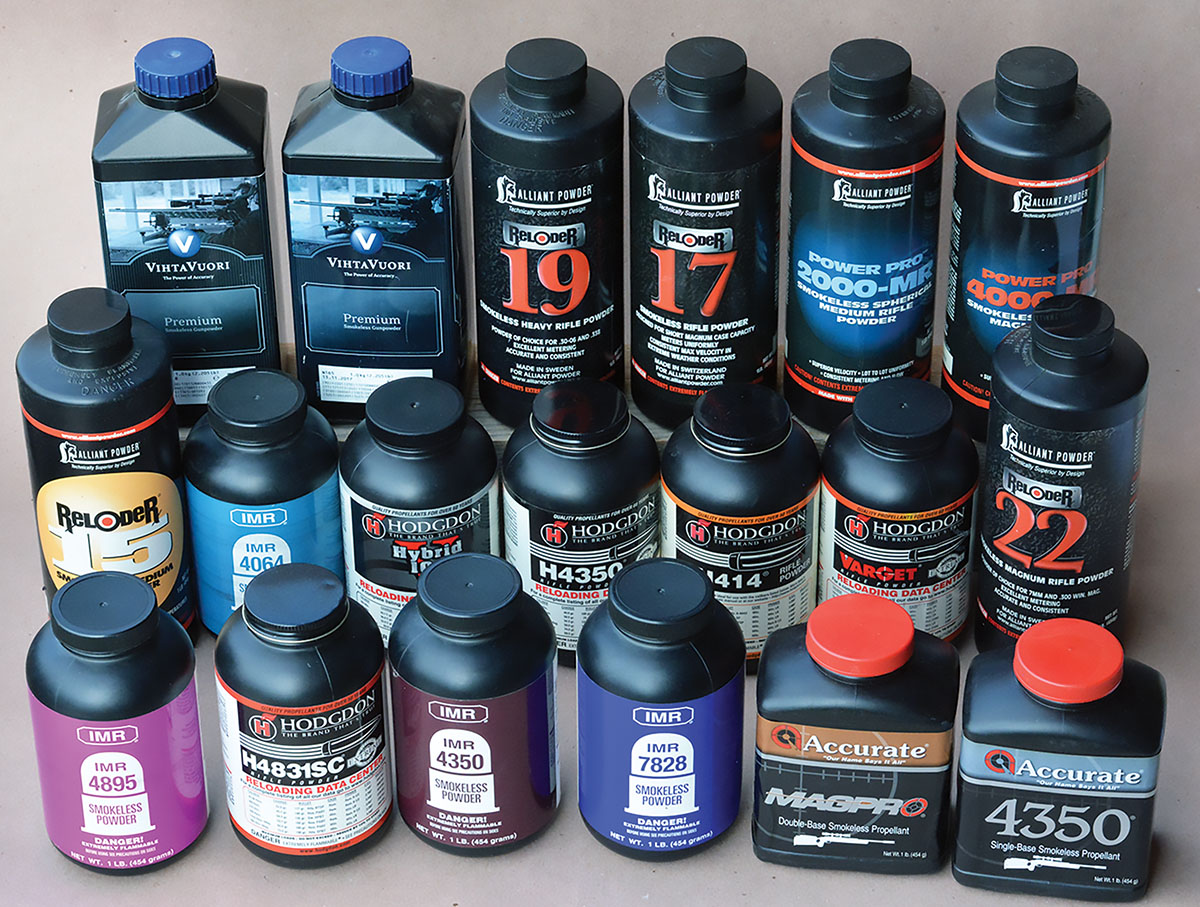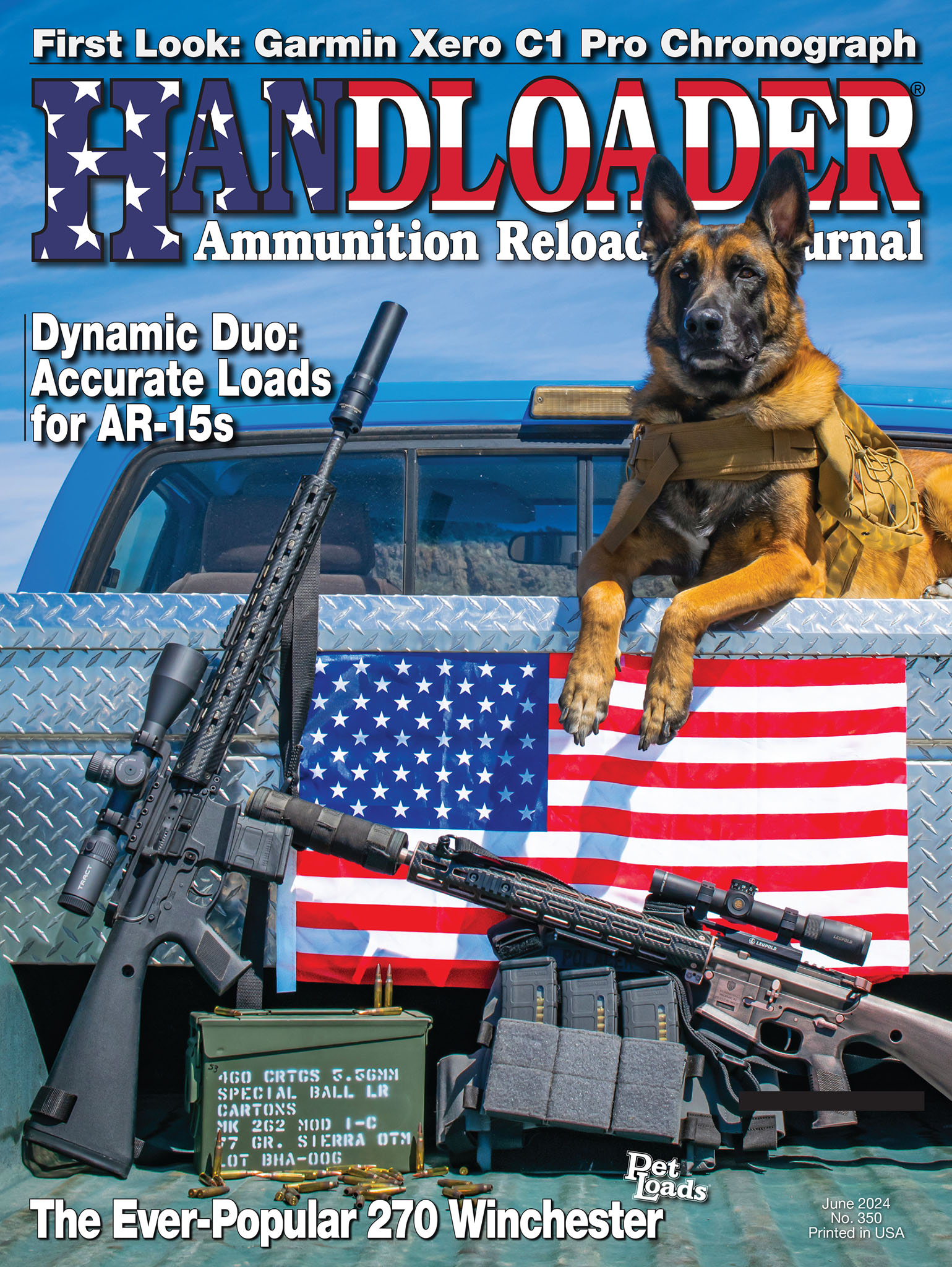In 1923, Winchester engineers developed a new sporting cartridge that was destined to become hugely popular with hunters, which resulted in additional cartridge developments intended to compete. However, the 270 WCF, more commonly known as the 270 Winchester, was not formally introduced until 1925 (the same year the 300 H&H Magnum was introduced) along with the new Winchester Model 54 bolt-action rifle, which was the predecessor to the famed Winchester Model 70.
Despite being ahead of its time initially, sales were modest, as the 30-06 Springfield, being a thirty caliber, was still gaining widespread acceptance among sportsmen. But in time, the outstanding ballistics and other virtues that the 270 offered resulted in huge popularity and in spite of many new cartridges appearing designed to compete, it still enjoys brisk sales and is the most popular of all .277-inch calibers.

Ammunition manufacturers offer many outstanding premium hunting loads for the 270 Winchester.
The 270 has a bore diameter of .270 inch, while the groove diameter is .277 inch, which, when it was introduced, made it a rather unique caliber. The 30-06 Springfield is generally considered the parent case. However, the 270 case is specified at 2.540 inches long, while the 30-06 is 2.494 inches. So technically speaking, the 270 is based on a necked down 30-03 case. However, like the 30-06, the overall cartridge length is 3.340 inches.

Barrel marking: “WINCHESTER MODEL 70 270 WIN ONLY.”
The first Winchester factory load consisted of a 130-grain bullet with a muzzle velocity of 3,160 feet per second (fps), while a 150-grain bullet was soon offered at 2,770 fps, with that velocity soon increased to 2,800 fps. Also, a 100-grain bullet appeared (for varmint shooters) with a muzzle velocity of 3,580 fps. Today, many new bullet styles and weights have been offered; however, the 130-grain bullet appears to remain the most popular. Winchester currently lists various 130-grain bullets at around 3,060 fps and 150-grain versions at 2,850 fps. While ammunition companies often lower velocities when compared to period ballistics, some companies have increased the velocity of the 270. For instance, Hornady lists the 130-grain InterBond and SST bullets at 3,200 fps, which is impressive. Unfortunately, as of this writing neither of those loads was available to establish actual velocities in the two test rifles and compare them with handloading data. However, several loads came very close to duplicating those listed velocities.

Hodgdon H-4831 and H-4831sc are classic choices for handloading the 270 Winchester. The short cut version tends to meter better and does not bridge, but accuracy is often better with the original H-4831 version.
The 270 gained widespread praise among period gun writers, including Townsend Whelen, Jack O’Connor and even the big-bore enthusiast Elmer Keith. However, as hunters put it to the test on game, its reputation grew and its many virtues became apparent. For example, it offered an unusually flat trajectory out to any normal hunting distance. During that era, point-blank range was a standard reference to measure the effective distance that a “dead-on” hold could be used for hunting deer or similar-sized game and bullets would never impact above, or fall below a given vital zone size. In essence, when the 270 was sighted 3 inches high at 100 yards, the point-blank range for deer was something past 325 yards. Furthermore, hunters found the recoil moderate, which helped reduce flinch and many shooters could place shots more precisely.

The 270 Winchester is a unique caliber that utilizes .277-inch bullets.
The 270’s terminal performance was impressive, especially considering that it was a light caliber. I think Elmer Keith said it best in his book,
Big Game Rifles and Cartridges. “The .270 Winchester is one of our most popular long range rifles and is a very good cartridge for all our lighter game. ”It is also an extremely accurate load, even at long range.” Many hunters swear by it for elk and moose shooting, but I have noticed that they are nearly all very experienced old hunters, who possess the skill and patience to properly place their shot or else not shoot.”

The maximum case length is 2.540 inches, while the suggested trim-to length is 2.530 inches.
It seems nearly impossible not to mention Jack O’Connor when discussing the 270. He probably did more to popularize it than any other single person as he penned his hunting adventures in
Outdoor Life, books and other periodicals. He took a huge variety of game with his custom Winchester Model 70 rifles, including elk, moose, African plains game and game in the four corners of the world. But just as Keith indicated, shot placement was an important ingredient to his success, especially on heavier game.

The maximum overall cartridge length for the 270 Winchester is 3.340 inches. However, many bullets will necessarily need to be seated to shorter lengths.
My personal experience with the 270 in the field is not limited. I purchased two Winchester pre-’64 Model 70s more than 40 years ago and put them to work in the field. In the years since, I have fired, tested and hunted with many rifles in that caliber and I hold the cartridge in high regard. Twenty-five years ago, I caught a plane to Kansas, where I took a large whitetail buck with a Thompson/Center Encore rifle. From there, I flew to Texas, where many feral hogs were taken with a prototype bolt-action 270, along with some exotic game, including nilgai (known to be tough) and several whitetail deer. The next stop was in Wyoming, where a nice antelope buck was taken with a borrowed Winchester Model 70 Classic rifle at 425 yards. From there, I flew to upstate New York to take a large whitetail deer, a sika deer and a European boar with the T/C Encore. Upon arriving home, I flew to Europe to hunt moose in Sweden wherein I was handed a borrowed custom Mauser 98 rifle chambered in 270. As a moose ran parallel at about 75 yards, a single well-placed shot with a Nosler 150-grain Partition bullet put him down within just a few yards. In reflecting on that busy fall, no game was wounded and every animal was taken cleanly with a single shot. In essence, use the right bullet for the job at hand, place the shot correctly and the 270 is wonderful. It is the quintessential deer, antelope and sheep cartridge, but when loaded with modern premium bullets designed for deep penetration on heavier game such as the Nosler Partition, Swift A-Frame, Barnes Triple Shock X-Bullet, Hornady GMX and kept within reasonable limits, it is suitable for elk, moose and similar game.

The 270 Winchester is a hunting cartridge with many premium bullets readily available.
For the first 20 years, the 270 Winchester was the only commercial .277-caliber cartridge and essentially unchallenged. But around 1943, Roy Weatherby developed his own proprietary 270 Magnum that was based on the 375/300 H&H belted case blown out and with an overall length of 3.295 inches. It offered around a 200 to 300 fps velocity increase over the 270 Winchester and is an impressive cartridge on its own merits. The subsequent notable .277-caliber cartridge development occurred in 2002, when Winchester offered the 270 WSM that was designed for 308 Winchester-length actions. It offered around 200-250 fps velocity increase over the original 270. In early 2020, Nosler introduced the 27 Nosler that is based on a modified 404 Jeffery case and has an overall length of 3.340 inches but was paired with rifles featuring a 1:8.5 barrel twist to ideally stabilize heavyweight, long for caliber, high-ballistic coefficient (BC) bullets for ultra-long range shooting. It likewise offers velocity advantages over the 270 Winchester, but again, it is designed for heavy-for-caliber bullets. Finally, we have the 6.8 Western introduced in 2021 by Winchester. Like the 270 WSM, the 6.8 is based on a modified 404 Jeffery case, offers around a 200 fps velocity advantage and will work in 308 length actions. However, it is designed specifically for heavy for caliber, high-BC bullets and is listed with barrel twist rates from 1:7.5 to 1:8 inches. The 27 Nosler and 6.8 Western with their fast twist barrels are not really intended for, or designed for typical 130- to 150-grain bullets that work optimally in the 270 Winchester making comparisons impractical. (Two additional .277-inch cartridges include the 6.8 SPC and 277 SIG Fury; however, both are specialized and not designed for conventional bolt-action rifles.)

Brian used two rifles chambered in 270 Winchester to develop “Pet Loads” data that included a Winchester Model 70 Classic Featherweight JOC Tribute rifle with a 22-inch barrel (left) and a Thompson/Center Encore with a 24-inch barrel (right).
Despite the above competition from cartridges that go faster, shoot further, feature a more modern case design, with increased shoulder angles, can be housed in short actions, etc., the original 270 Winchester still boasts of the highest sales and finds great favor among sportsmen and hunters. It is available in many rifle configurations, it feeds flawlessly, is relatively easy on barrels, meets the needs of most hunters, can take deer at practical distances and ammunition is widely available from many different manufacturers at a modest cost. Winchester’s 270 is a true classic. Two rifles were used to develop the accompanying data. Rifle trends are continually changing so selecting a barrel length to establish velocities can be difficult. For example, when the 270 was originally introduced, a 24-inch barrel was standard, but 30 years later, the trend changed to 22 inches and during the 1980s and 1990s, rifles with 20-inch barrels found some favor. For the past 20-plus years, 24-inch (or longer) barrels have been trending. So, to establish velocities a Thompson/Center Arms Encore with 24-inch barrel was used that is also the same length used by ammunition companies to establish velocities. However, while that barrel was being cooled after a string of shots using a compressor-driven air system, the accuracy testing was conducted using a handsome Winchester Model 70 Classic Featherweight Jack O’Connor tribute rifle with a 22-inch barrel.

The 270 Winchester is the original .277-inch cartridge and remains by far the most popular. Additional .277-caliber cartridges generally offer magnum-like performance. Examples include: (1) 270 Winchester, (2) 270 Weatherby Magnum, (3) 270 WSM, (4) 6.8 Western and (5) 27 Nosler.
Generally, cases should be full-length sized to ensure easy chambering of reloaded cartridges, which is vital for a hunting rifle. However, if handloading for just one rifle housed in a bolt-action or single-shot configuration, neck sizing is a viable option that can improve accuracy and extend case life, but care should be taken to be certain that all cartridges readily chamber before taking those handloads into the field. If handloading for a pump, autoloading or lever-action rifle, a small base sizing die should be considered to assure that cartridges will readily chamber.
Case capacity does vary from one manufacturer to the next and can even vary from the same manufacturer. It is always advisable to use cases from one manufacturer and are all from the same lot number. Cases with less capacity will reach maximum pressures sooner than cases with a larger capacity, which is a reminder to avoid beginning with maximum loads. In some instances, cases with less capacity may not hold maximum charges of slow-burning powders. Winchester cases were used exclusively to develop the accompanying “Pet Loads” data, which offer more capacity than cases from most other manufacturers. Also, a lot of data has been published using Large Rifle Magnum primers with the 270. However, all data herein was developed using CCI BR-2 Large Rifle Standard primers. There was never an indication of hangfire loads or unusually high extreme spreads in spite of being fired during Idaho winter months. Primers should be seated .003 to .005 below flush with the anvil properly contacting the bottom of the primer pocket.
The suitable powder selection is broad, but includes Hodgdon Varget, IMR-4895, Alliant Reloder 15 and several others for 90- to 110-grain bullets. Jumping in bullet weight to the widely popular 130- grains (and heavier), notable powders included H-4350, H-4831sc, Hybrid 100V, Alliant Power Pro 4000-MR, RL-17, RL-19, RL-22, Vihtavuori N-165, A-4350 and others gave excellent velocities and top accuracy. Notably, that Jack O’Connor used the Nosler 130-grain Partition bullet pushed with 62 grains of 4831 powder capped with the CCI 250 primer.

The 270 Winchester has proven to be an accurate cartridge with any reasonable handload.
With only a few exceptions, rifles chambered for 270 have been fitted with a 1:10 barrel twist rate. This rifling offers ideal stabilization for bullet weights from 90 to 150 grains and both test rifles worked well with the Nosler 160-grain Partition at 100 yards. Many have speculated that with all the new high-BC, low drag, heavy-for-caliber bullets designed for the 27 Nosler and 6.8 Western, the 270 could be used in conjunction with the Nosler 165-grain Trophy Grade, the Winchester 162-grain Copper Impact, Winchester 170-grain Match and Ballistic Silvertip and even the Browning 175-grain Long Range Pro Hunter bullets. Preliminary tests suggest this is not a great combination, as the comparatively slow twist does not provide proper stabilization and resulted in poor accuracy. Rather, these bullets generally need at least a 1:8.5 barrel twist rate.
The 270 has historically had a maximum average pressure of 52,000 CUP; however, with modern piezoelectric pressure measurement methods, the Sporting Arms and Ammunition Manufacturers’ Institute (SAAMI) has updated that figure to 65,000 psi. Most of the accompanying data has been pressure tested and is within that limit.
Very few sporting cartridges can equal the widespread and long lasting popularity that the 270 Winchester has achieved, which is due to its wonderful blend of modest recoil, flat trajectory, accuracy, efficiency, performance on game and several other virtues. In developing the accompanying “Pet Loads” data, I was quickly reminded (not that I had forgotten) just how sweet this “oldie but goodie” really is!

Brian used a variety of extruded and spherical powders to develop 270 Winchester “Pet Loads” data.












.jpg)
.jpg)
.jpg)
.jpg)


